Developments, Demand Factors and Impacts on Travel & Tourism
VerifiedAdded on 2023/04/04
|15
|4206
|96
Report
AI Summary
This report provides a detailed analysis of the travel and tourism sector, focusing on key developments, structural elements, and the impact of political changes. It examines factors affecting tourism demand, including political, economic, and quality-related aspects, and discusses how supply changes influence demand. Furthermore, the report assesses the positive and negative social, economic, and environmental impacts of tourism, proposing strategies to mitigate the negative effects. The analysis includes considerations for regulations, transportation, technology, and lifestyle changes, highlighting their roles in shaping the industry. It also touches upon the importance of political stability for tourism growth, using Thomas Cook as an example to illustrate global market dynamics and customer considerations. Desklib offers this assignment solution along with a wealth of study tools for students.
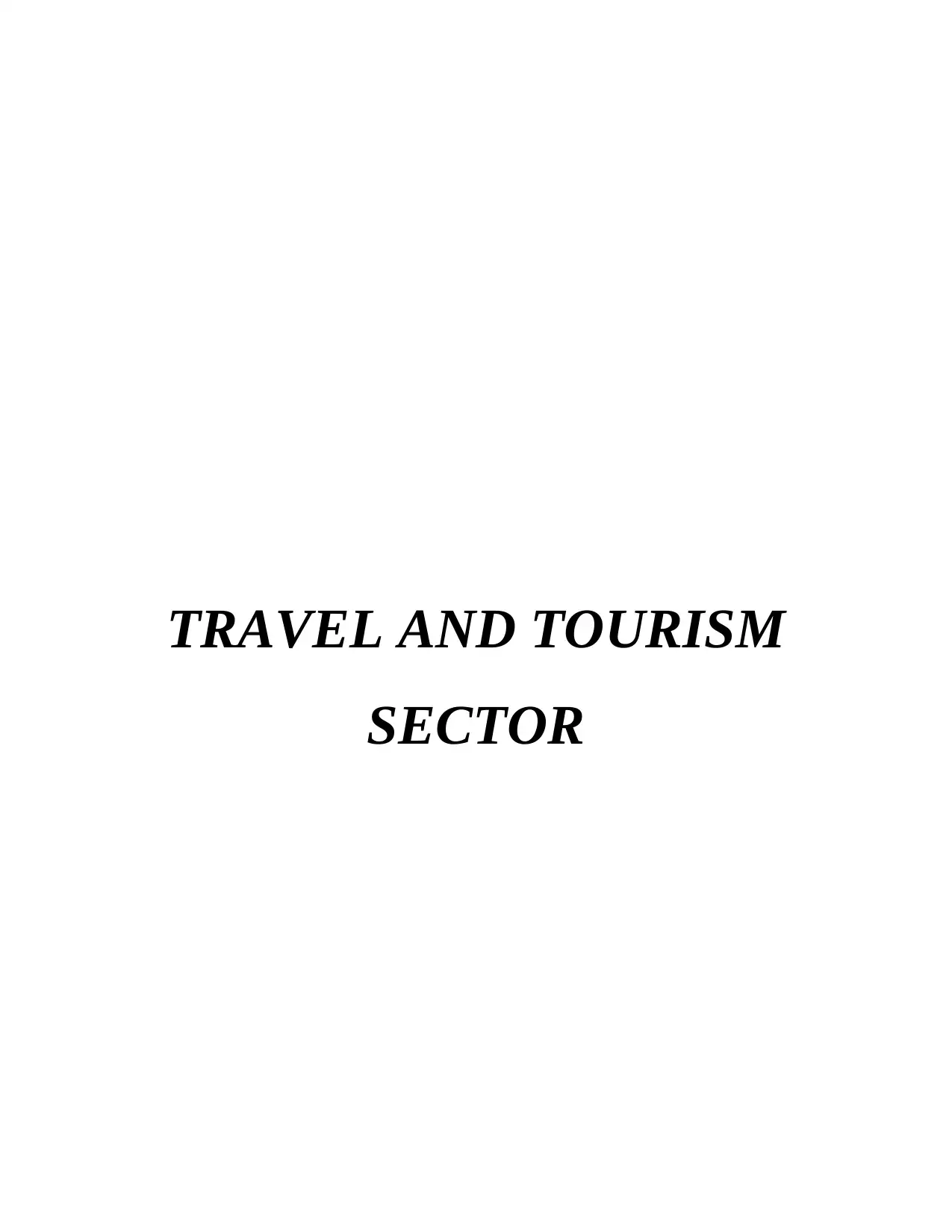
TRAVEL AND TOURISM
SECTOR
SECTOR
Paraphrase This Document
Need a fresh take? Get an instant paraphrase of this document with our AI Paraphraser
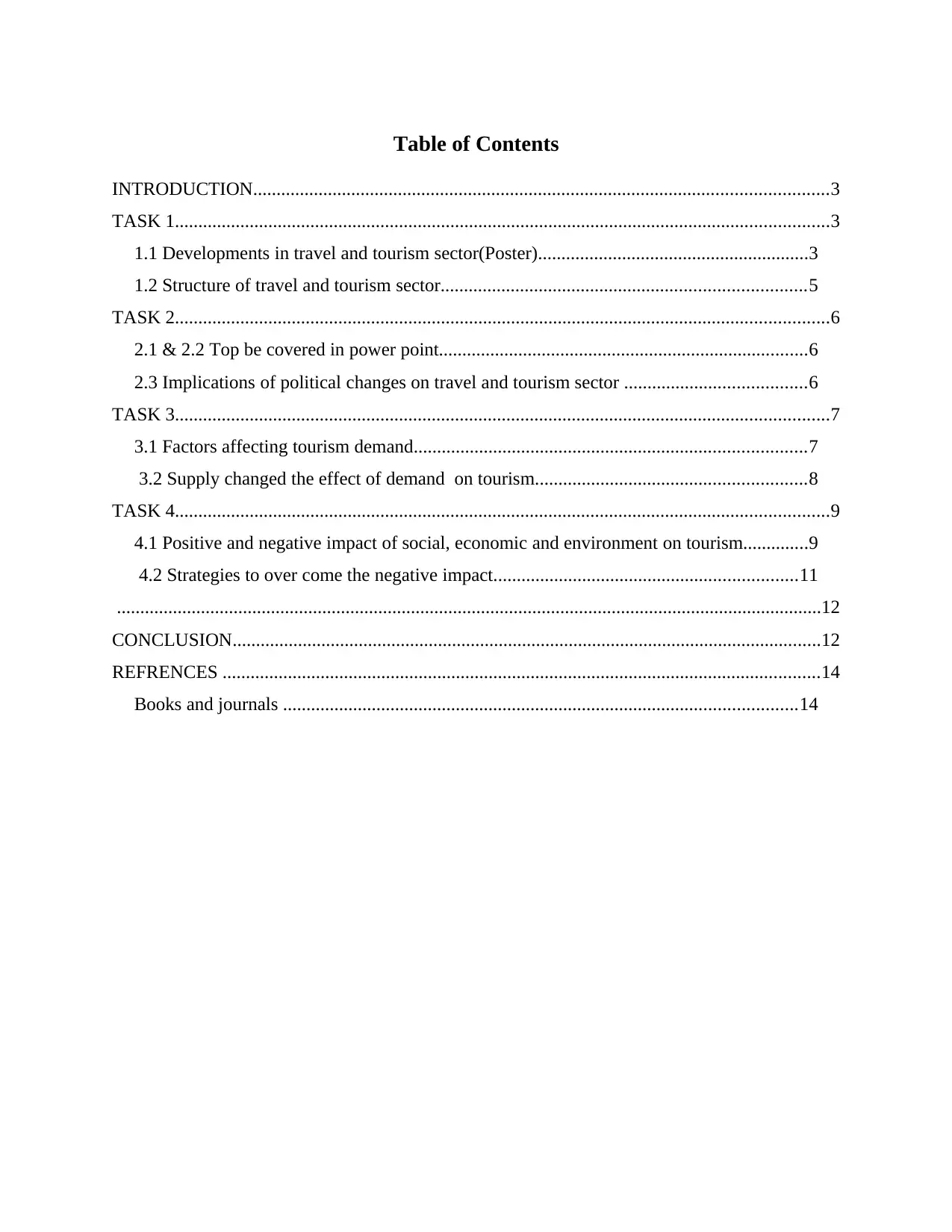
Table of Contents
INTRODUCTION...........................................................................................................................3
TASK 1............................................................................................................................................3
1.1 Developments in travel and tourism sector(Poster)..........................................................3
1.2 Structure of travel and tourism sector..............................................................................5
TASK 2............................................................................................................................................6
2.1 & 2.2 Top be covered in power point...............................................................................6
2.3 Implications of political changes on travel and tourism sector .......................................6
TASK 3............................................................................................................................................7
3.1 Factors affecting tourism demand....................................................................................7
3.2 Supply changed the effect of demand on tourism..........................................................8
TASK 4............................................................................................................................................9
4.1 Positive and negative impact of social, economic and environment on tourism..............9
4.2 Strategies to over come the negative impact.................................................................11
.......................................................................................................................................................12
CONCLUSION..............................................................................................................................12
REFRENCES ................................................................................................................................14
Books and journals ..............................................................................................................14
INTRODUCTION...........................................................................................................................3
TASK 1............................................................................................................................................3
1.1 Developments in travel and tourism sector(Poster)..........................................................3
1.2 Structure of travel and tourism sector..............................................................................5
TASK 2............................................................................................................................................6
2.1 & 2.2 Top be covered in power point...............................................................................6
2.3 Implications of political changes on travel and tourism sector .......................................6
TASK 3............................................................................................................................................7
3.1 Factors affecting tourism demand....................................................................................7
3.2 Supply changed the effect of demand on tourism..........................................................8
TASK 4............................................................................................................................................9
4.1 Positive and negative impact of social, economic and environment on tourism..............9
4.2 Strategies to over come the negative impact.................................................................11
.......................................................................................................................................................12
CONCLUSION..............................................................................................................................12
REFRENCES ................................................................................................................................14
Books and journals ..............................................................................................................14
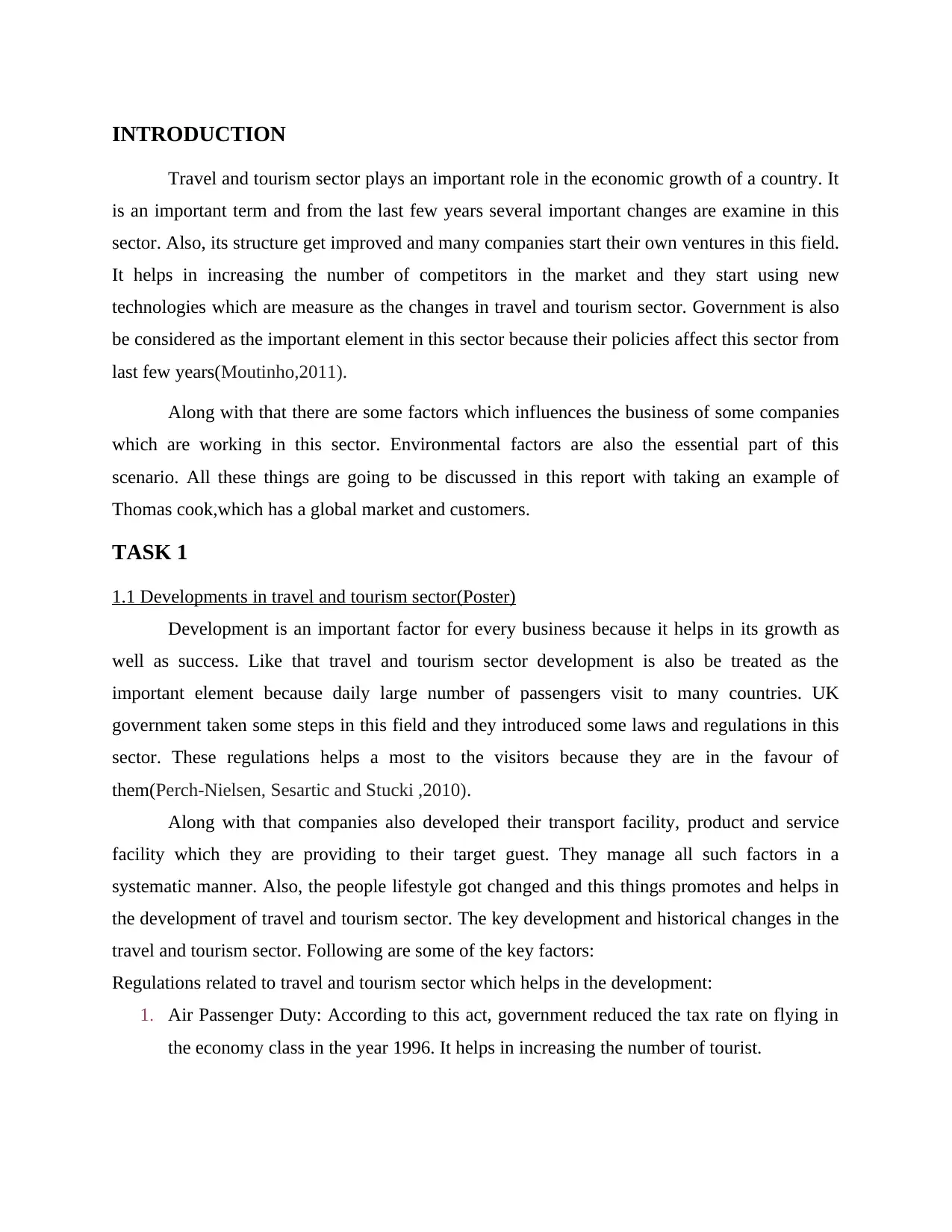
INTRODUCTION
Travel and tourism sector plays an important role in the economic growth of a country. It
is an important term and from the last few years several important changes are examine in this
sector. Also, its structure get improved and many companies start their own ventures in this field.
It helps in increasing the number of competitors in the market and they start using new
technologies which are measure as the changes in travel and tourism sector. Government is also
be considered as the important element in this sector because their policies affect this sector from
last few years(Moutinho,2011).
Along with that there are some factors which influences the business of some companies
which are working in this sector. Environmental factors are also the essential part of this
scenario. All these things are going to be discussed in this report with taking an example of
Thomas cook,which has a global market and customers.
TASK 1
1.1 Developments in travel and tourism sector(Poster)
Development is an important factor for every business because it helps in its growth as
well as success. Like that travel and tourism sector development is also be treated as the
important element because daily large number of passengers visit to many countries. UK
government taken some steps in this field and they introduced some laws and regulations in this
sector. These regulations helps a most to the visitors because they are in the favour of
them(Perch-Nielsen, Sesartic and Stucki ,2010).
Along with that companies also developed their transport facility, product and service
facility which they are providing to their target guest. They manage all such factors in a
systematic manner. Also, the people lifestyle got changed and this things promotes and helps in
the development of travel and tourism sector. The key development and historical changes in the
travel and tourism sector. Following are some of the key factors:
Regulations related to travel and tourism sector which helps in the development:
1. Air Passenger Duty: According to this act, government reduced the tax rate on flying in
the economy class in the year 1996. It helps in increasing the number of tourist.
Travel and tourism sector plays an important role in the economic growth of a country. It
is an important term and from the last few years several important changes are examine in this
sector. Also, its structure get improved and many companies start their own ventures in this field.
It helps in increasing the number of competitors in the market and they start using new
technologies which are measure as the changes in travel and tourism sector. Government is also
be considered as the important element in this sector because their policies affect this sector from
last few years(Moutinho,2011).
Along with that there are some factors which influences the business of some companies
which are working in this sector. Environmental factors are also the essential part of this
scenario. All these things are going to be discussed in this report with taking an example of
Thomas cook,which has a global market and customers.
TASK 1
1.1 Developments in travel and tourism sector(Poster)
Development is an important factor for every business because it helps in its growth as
well as success. Like that travel and tourism sector development is also be treated as the
important element because daily large number of passengers visit to many countries. UK
government taken some steps in this field and they introduced some laws and regulations in this
sector. These regulations helps a most to the visitors because they are in the favour of
them(Perch-Nielsen, Sesartic and Stucki ,2010).
Along with that companies also developed their transport facility, product and service
facility which they are providing to their target guest. They manage all such factors in a
systematic manner. Also, the people lifestyle got changed and this things promotes and helps in
the development of travel and tourism sector. The key development and historical changes in the
travel and tourism sector. Following are some of the key factors:
Regulations related to travel and tourism sector which helps in the development:
1. Air Passenger Duty: According to this act, government reduced the tax rate on flying in
the economy class in the year 1996. It helps in increasing the number of tourist.
⊘ This is a preview!⊘
Do you want full access?
Subscribe today to unlock all pages.

Trusted by 1+ million students worldwide
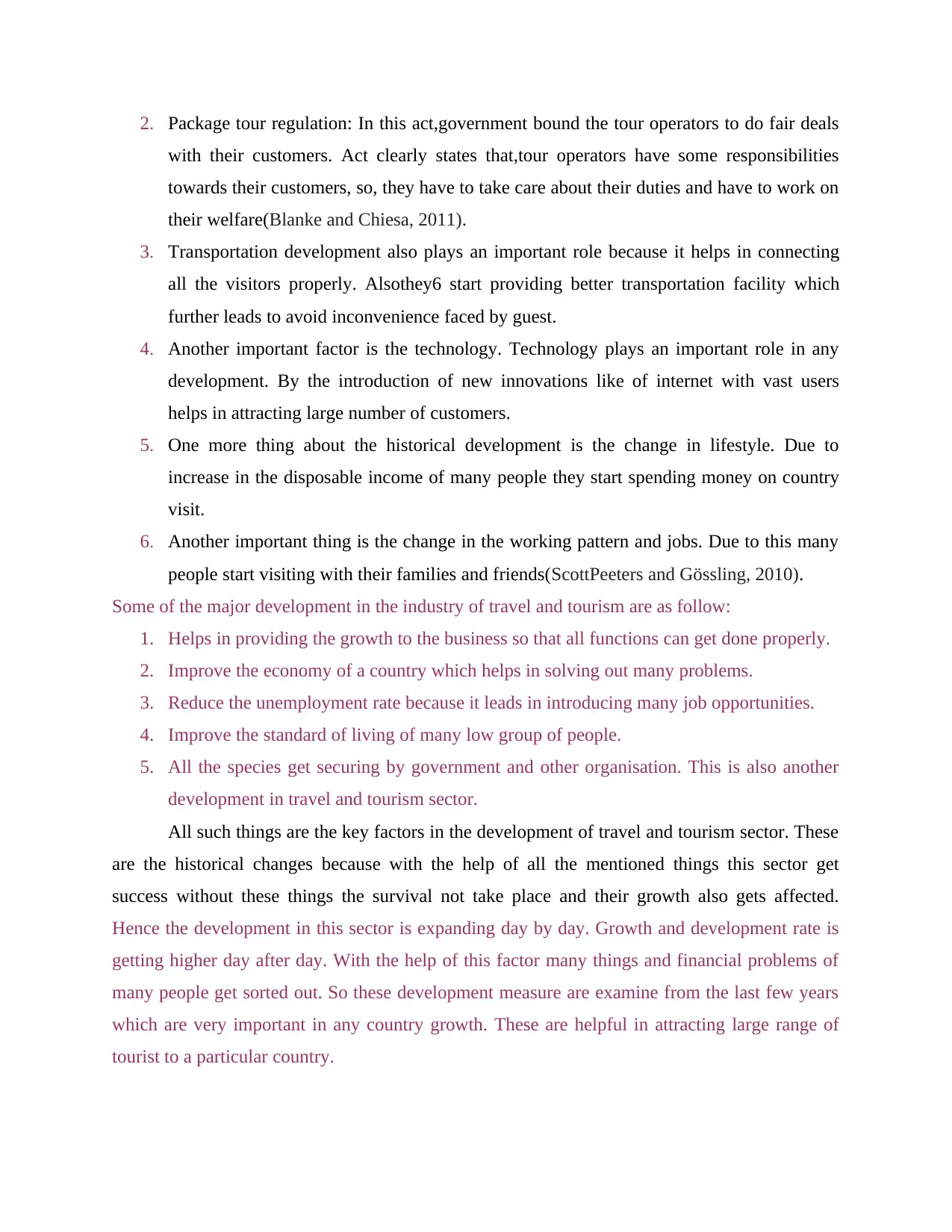
2. Package tour regulation: In this act,government bound the tour operators to do fair deals
with their customers. Act clearly states that,tour operators have some responsibilities
towards their customers, so, they have to take care about their duties and have to work on
their welfare(Blanke and Chiesa, 2011).
3. Transportation development also plays an important role because it helps in connecting
all the visitors properly. Alsothey6 start providing better transportation facility which
further leads to avoid inconvenience faced by guest.
4. Another important factor is the technology. Technology plays an important role in any
development. By the introduction of new innovations like of internet with vast users
helps in attracting large number of customers.
5. One more thing about the historical development is the change in lifestyle. Due to
increase in the disposable income of many people they start spending money on country
visit.
6. Another important thing is the change in the working pattern and jobs. Due to this many
people start visiting with their families and friends(ScottPeeters and Gössling, 2010).
Some of the major development in the industry of travel and tourism are as follow:
1. Helps in providing the growth to the business so that all functions can get done properly.
2. Improve the economy of a country which helps in solving out many problems.
3. Reduce the unemployment rate because it leads in introducing many job opportunities.
4. Improve the standard of living of many low group of people.
5. All the species get securing by government and other organisation. This is also another
development in travel and tourism sector.
All such things are the key factors in the development of travel and tourism sector. These
are the historical changes because with the help of all the mentioned things this sector get
success without these things the survival not take place and their growth also gets affected.
Hence the development in this sector is expanding day by day. Growth and development rate is
getting higher day after day. With the help of this factor many things and financial problems of
many people get sorted out. So these development measure are examine from the last few years
which are very important in any country growth. These are helpful in attracting large range of
tourist to a particular country.
with their customers. Act clearly states that,tour operators have some responsibilities
towards their customers, so, they have to take care about their duties and have to work on
their welfare(Blanke and Chiesa, 2011).
3. Transportation development also plays an important role because it helps in connecting
all the visitors properly. Alsothey6 start providing better transportation facility which
further leads to avoid inconvenience faced by guest.
4. Another important factor is the technology. Technology plays an important role in any
development. By the introduction of new innovations like of internet with vast users
helps in attracting large number of customers.
5. One more thing about the historical development is the change in lifestyle. Due to
increase in the disposable income of many people they start spending money on country
visit.
6. Another important thing is the change in the working pattern and jobs. Due to this many
people start visiting with their families and friends(ScottPeeters and Gössling, 2010).
Some of the major development in the industry of travel and tourism are as follow:
1. Helps in providing the growth to the business so that all functions can get done properly.
2. Improve the economy of a country which helps in solving out many problems.
3. Reduce the unemployment rate because it leads in introducing many job opportunities.
4. Improve the standard of living of many low group of people.
5. All the species get securing by government and other organisation. This is also another
development in travel and tourism sector.
All such things are the key factors in the development of travel and tourism sector. These
are the historical changes because with the help of all the mentioned things this sector get
success without these things the survival not take place and their growth also gets affected.
Hence the development in this sector is expanding day by day. Growth and development rate is
getting higher day after day. With the help of this factor many things and financial problems of
many people get sorted out. So these development measure are examine from the last few years
which are very important in any country growth. These are helpful in attracting large range of
tourist to a particular country.
Paraphrase This Document
Need a fresh take? Get an instant paraphrase of this document with our AI Paraphraser
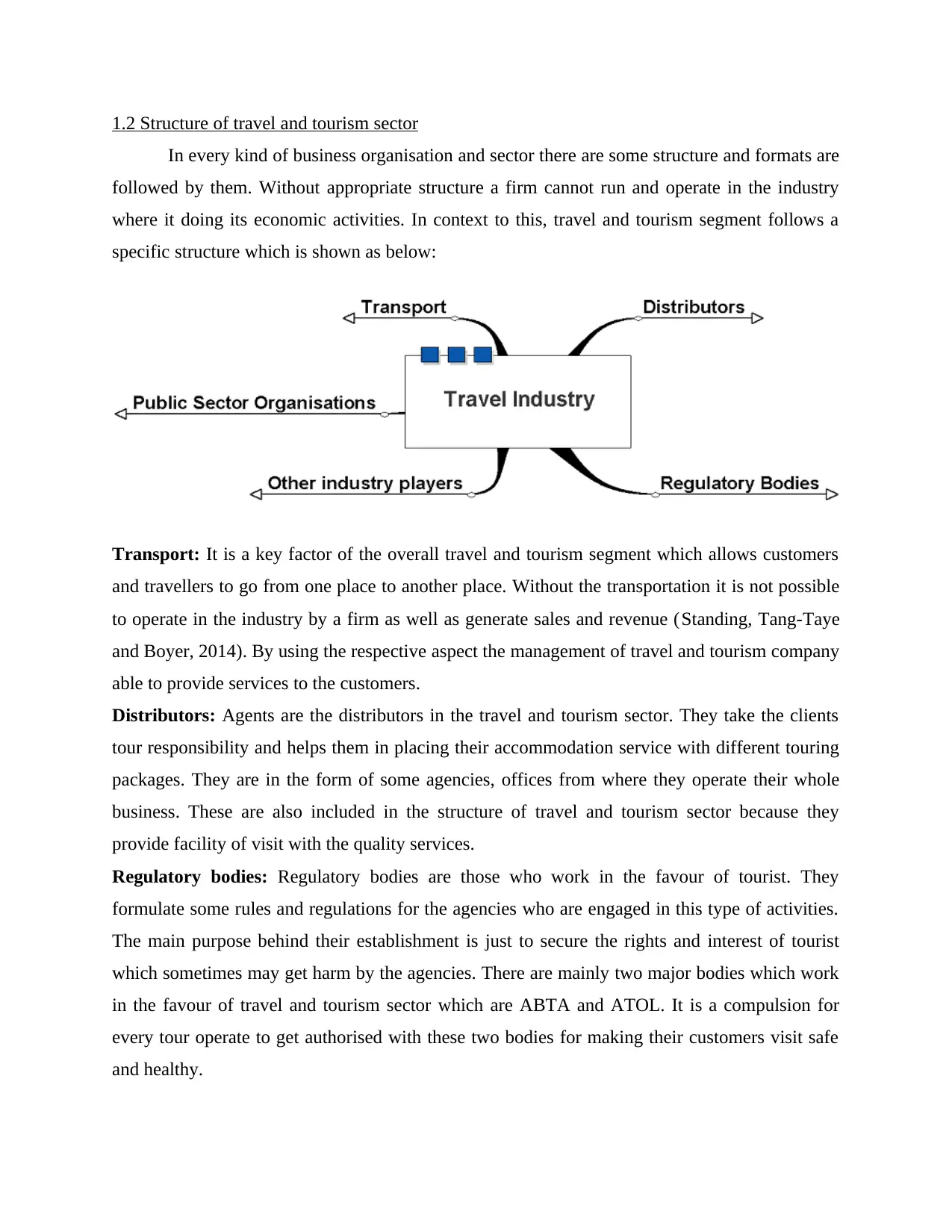
1.2 Structure of travel and tourism sector
In every kind of business organisation and sector there are some structure and formats are
followed by them. Without appropriate structure a firm cannot run and operate in the industry
where it doing its economic activities. In context to this, travel and tourism segment follows a
specific structure which is shown as below:
Transport: It is a key factor of the overall travel and tourism segment which allows customers
and travellers to go from one place to another place. Without the transportation it is not possible
to operate in the industry by a firm as well as generate sales and revenue (Standing, Tang-Taye
and Boyer, 2014). By using the respective aspect the management of travel and tourism company
able to provide services to the customers.
Distributors: Agents are the distributors in the travel and tourism sector. They take the clients
tour responsibility and helps them in placing their accommodation service with different touring
packages. They are in the form of some agencies, offices from where they operate their whole
business. These are also included in the structure of travel and tourism sector because they
provide facility of visit with the quality services.
Regulatory bodies: Regulatory bodies are those who work in the favour of tourist. They
formulate some rules and regulations for the agencies who are engaged in this type of activities.
The main purpose behind their establishment is just to secure the rights and interest of tourist
which sometimes may get harm by the agencies. There are mainly two major bodies which work
in the favour of travel and tourism sector which are ABTA and ATOL. It is a compulsion for
every tour operate to get authorised with these two bodies for making their customers visit safe
and healthy.
In every kind of business organisation and sector there are some structure and formats are
followed by them. Without appropriate structure a firm cannot run and operate in the industry
where it doing its economic activities. In context to this, travel and tourism segment follows a
specific structure which is shown as below:
Transport: It is a key factor of the overall travel and tourism segment which allows customers
and travellers to go from one place to another place. Without the transportation it is not possible
to operate in the industry by a firm as well as generate sales and revenue (Standing, Tang-Taye
and Boyer, 2014). By using the respective aspect the management of travel and tourism company
able to provide services to the customers.
Distributors: Agents are the distributors in the travel and tourism sector. They take the clients
tour responsibility and helps them in placing their accommodation service with different touring
packages. They are in the form of some agencies, offices from where they operate their whole
business. These are also included in the structure of travel and tourism sector because they
provide facility of visit with the quality services.
Regulatory bodies: Regulatory bodies are those who work in the favour of tourist. They
formulate some rules and regulations for the agencies who are engaged in this type of activities.
The main purpose behind their establishment is just to secure the rights and interest of tourist
which sometimes may get harm by the agencies. There are mainly two major bodies which work
in the favour of travel and tourism sector which are ABTA and ATOL. It is a compulsion for
every tour operate to get authorised with these two bodies for making their customers visit safe
and healthy.
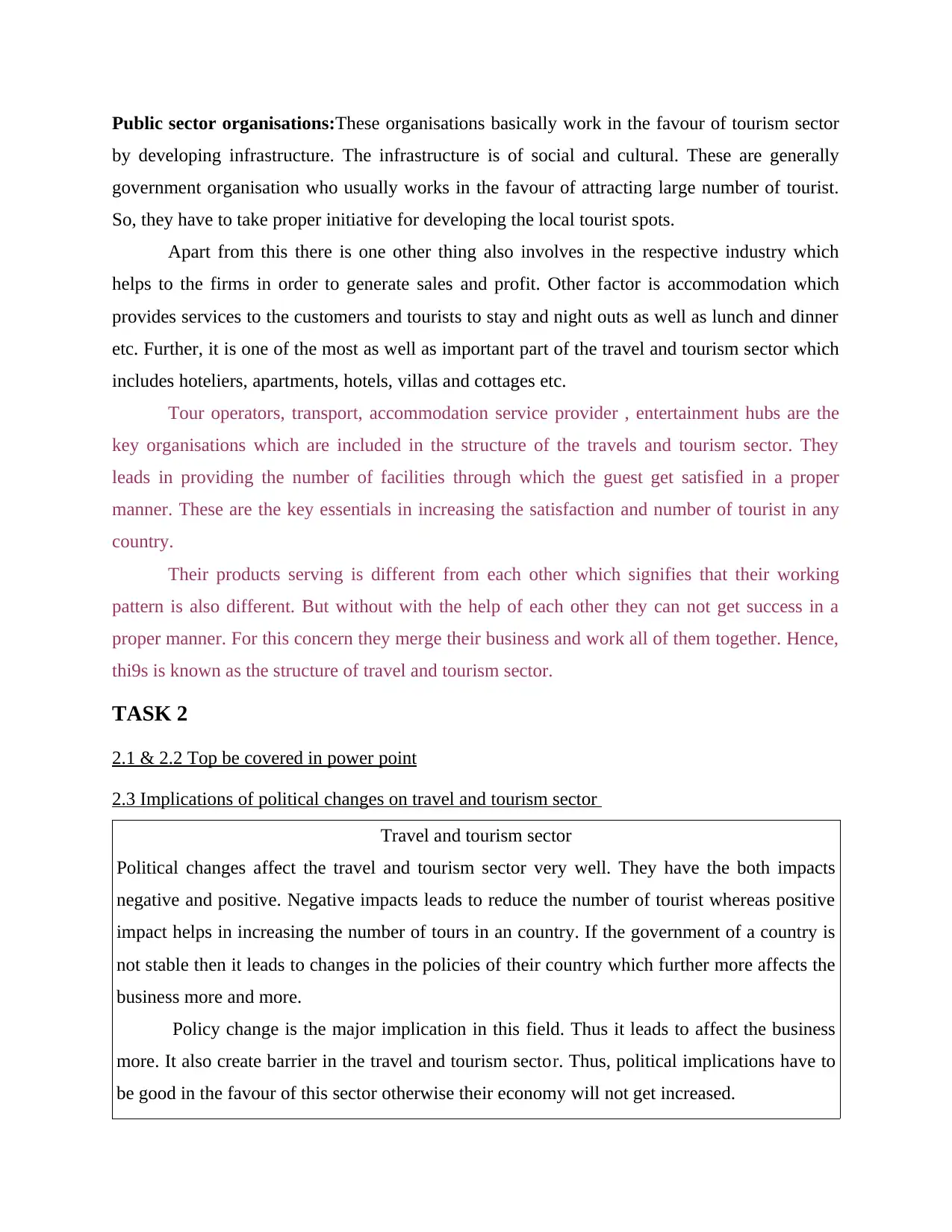
Public sector organisations:These organisations basically work in the favour of tourism sector
by developing infrastructure. The infrastructure is of social and cultural. These are generally
government organisation who usually works in the favour of attracting large number of tourist.
So, they have to take proper initiative for developing the local tourist spots.
Apart from this there is one other thing also involves in the respective industry which
helps to the firms in order to generate sales and profit. Other factor is accommodation which
provides services to the customers and tourists to stay and night outs as well as lunch and dinner
etc. Further, it is one of the most as well as important part of the travel and tourism sector which
includes hoteliers, apartments, hotels, villas and cottages etc.
Tour operators, transport, accommodation service provider , entertainment hubs are the
key organisations which are included in the structure of the travels and tourism sector. They
leads in providing the number of facilities through which the guest get satisfied in a proper
manner. These are the key essentials in increasing the satisfaction and number of tourist in any
country.
Their products serving is different from each other which signifies that their working
pattern is also different. But without with the help of each other they can not get success in a
proper manner. For this concern they merge their business and work all of them together. Hence,
thi9s is known as the structure of travel and tourism sector.
TASK 2
2.1 & 2.2 Top be covered in power point
2.3 Implications of political changes on travel and tourism sector
Travel and tourism sector
Political changes affect the travel and tourism sector very well. They have the both impacts
negative and positive. Negative impacts leads to reduce the number of tourist whereas positive
impact helps in increasing the number of tours in an country. If the government of a country is
not stable then it leads to changes in the policies of their country which further more affects the
business more and more.
Policy change is the major implication in this field. Thus it leads to affect the business
more. It also create barrier in the travel and tourism sector. Thus, political implications have to
be good in the favour of this sector otherwise their economy will not get increased.
by developing infrastructure. The infrastructure is of social and cultural. These are generally
government organisation who usually works in the favour of attracting large number of tourist.
So, they have to take proper initiative for developing the local tourist spots.
Apart from this there is one other thing also involves in the respective industry which
helps to the firms in order to generate sales and profit. Other factor is accommodation which
provides services to the customers and tourists to stay and night outs as well as lunch and dinner
etc. Further, it is one of the most as well as important part of the travel and tourism sector which
includes hoteliers, apartments, hotels, villas and cottages etc.
Tour operators, transport, accommodation service provider , entertainment hubs are the
key organisations which are included in the structure of the travels and tourism sector. They
leads in providing the number of facilities through which the guest get satisfied in a proper
manner. These are the key essentials in increasing the satisfaction and number of tourist in any
country.
Their products serving is different from each other which signifies that their working
pattern is also different. But without with the help of each other they can not get success in a
proper manner. For this concern they merge their business and work all of them together. Hence,
thi9s is known as the structure of travel and tourism sector.
TASK 2
2.1 & 2.2 Top be covered in power point
2.3 Implications of political changes on travel and tourism sector
Travel and tourism sector
Political changes affect the travel and tourism sector very well. They have the both impacts
negative and positive. Negative impacts leads to reduce the number of tourist whereas positive
impact helps in increasing the number of tours in an country. If the government of a country is
not stable then it leads to changes in the policies of their country which further more affects the
business more and more.
Policy change is the major implication in this field. Thus it leads to affect the business
more. It also create barrier in the travel and tourism sector. Thus, political implications have to
be good in the favour of this sector otherwise their economy will not get increased.
⊘ This is a preview!⊘
Do you want full access?
Subscribe today to unlock all pages.

Trusted by 1+ million students worldwide
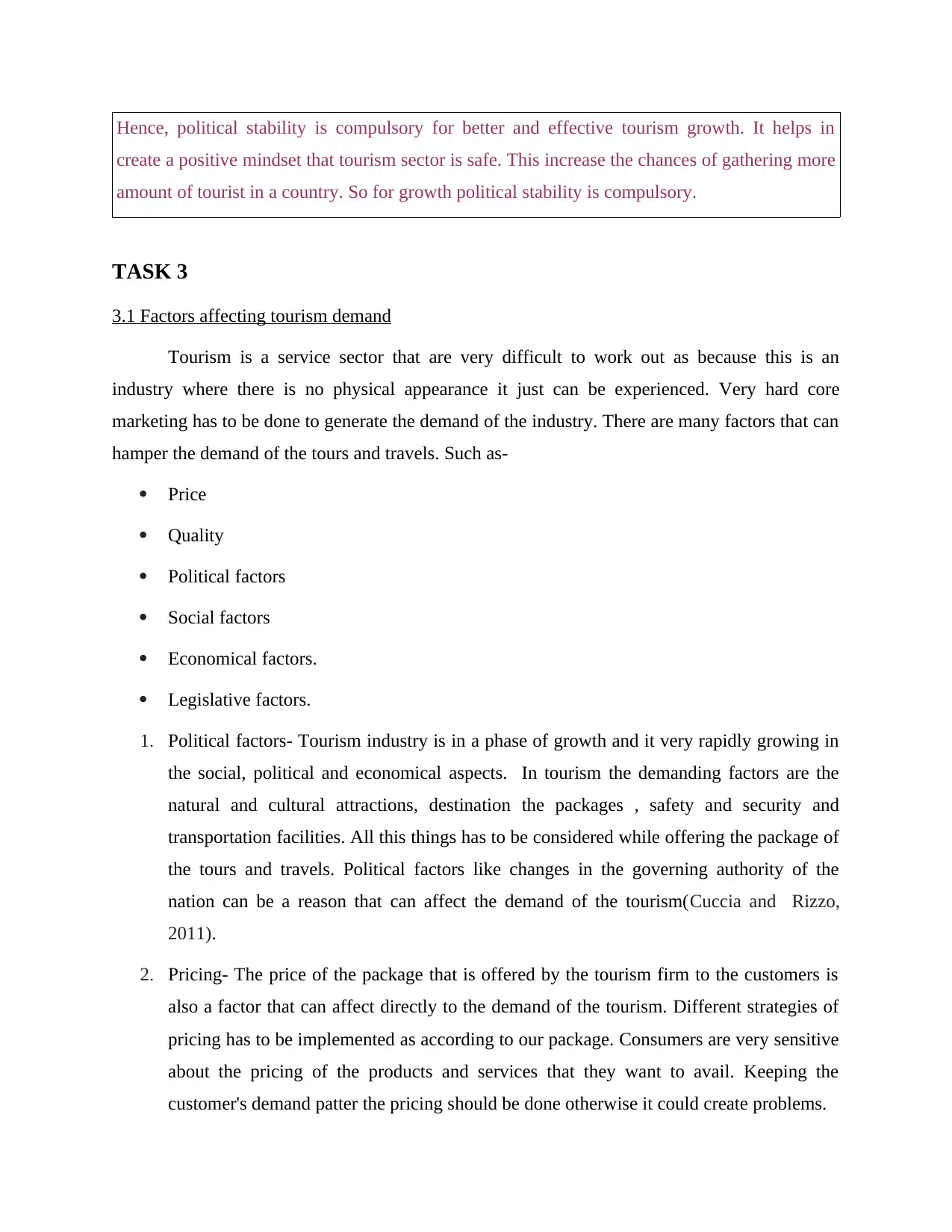
Hence, political stability is compulsory for better and effective tourism growth. It helps in
create a positive mindset that tourism sector is safe. This increase the chances of gathering more
amount of tourist in a country. So for growth political stability is compulsory.
TASK 3
3.1 Factors affecting tourism demand
Tourism is a service sector that are very difficult to work out as because this is an
industry where there is no physical appearance it just can be experienced. Very hard core
marketing has to be done to generate the demand of the industry. There are many factors that can
hamper the demand of the tours and travels. Such as-
Price
Quality
Political factors
Social factors
Economical factors.
Legislative factors.
1. Political factors- Tourism industry is in a phase of growth and it very rapidly growing in
the social, political and economical aspects. In tourism the demanding factors are the
natural and cultural attractions, destination the packages , safety and security and
transportation facilities. All this things has to be considered while offering the package of
the tours and travels. Political factors like changes in the governing authority of the
nation can be a reason that can affect the demand of the tourism(Cuccia and Rizzo,
2011).
2. Pricing- The price of the package that is offered by the tourism firm to the customers is
also a factor that can affect directly to the demand of the tourism. Different strategies of
pricing has to be implemented as according to our package. Consumers are very sensitive
about the pricing of the products and services that they want to avail. Keeping the
customer's demand patter the pricing should be done otherwise it could create problems.
create a positive mindset that tourism sector is safe. This increase the chances of gathering more
amount of tourist in a country. So for growth political stability is compulsory.
TASK 3
3.1 Factors affecting tourism demand
Tourism is a service sector that are very difficult to work out as because this is an
industry where there is no physical appearance it just can be experienced. Very hard core
marketing has to be done to generate the demand of the industry. There are many factors that can
hamper the demand of the tours and travels. Such as-
Price
Quality
Political factors
Social factors
Economical factors.
Legislative factors.
1. Political factors- Tourism industry is in a phase of growth and it very rapidly growing in
the social, political and economical aspects. In tourism the demanding factors are the
natural and cultural attractions, destination the packages , safety and security and
transportation facilities. All this things has to be considered while offering the package of
the tours and travels. Political factors like changes in the governing authority of the
nation can be a reason that can affect the demand of the tourism(Cuccia and Rizzo,
2011).
2. Pricing- The price of the package that is offered by the tourism firm to the customers is
also a factor that can affect directly to the demand of the tourism. Different strategies of
pricing has to be implemented as according to our package. Consumers are very sensitive
about the pricing of the products and services that they want to avail. Keeping the
customer's demand patter the pricing should be done otherwise it could create problems.
Paraphrase This Document
Need a fresh take? Get an instant paraphrase of this document with our AI Paraphraser
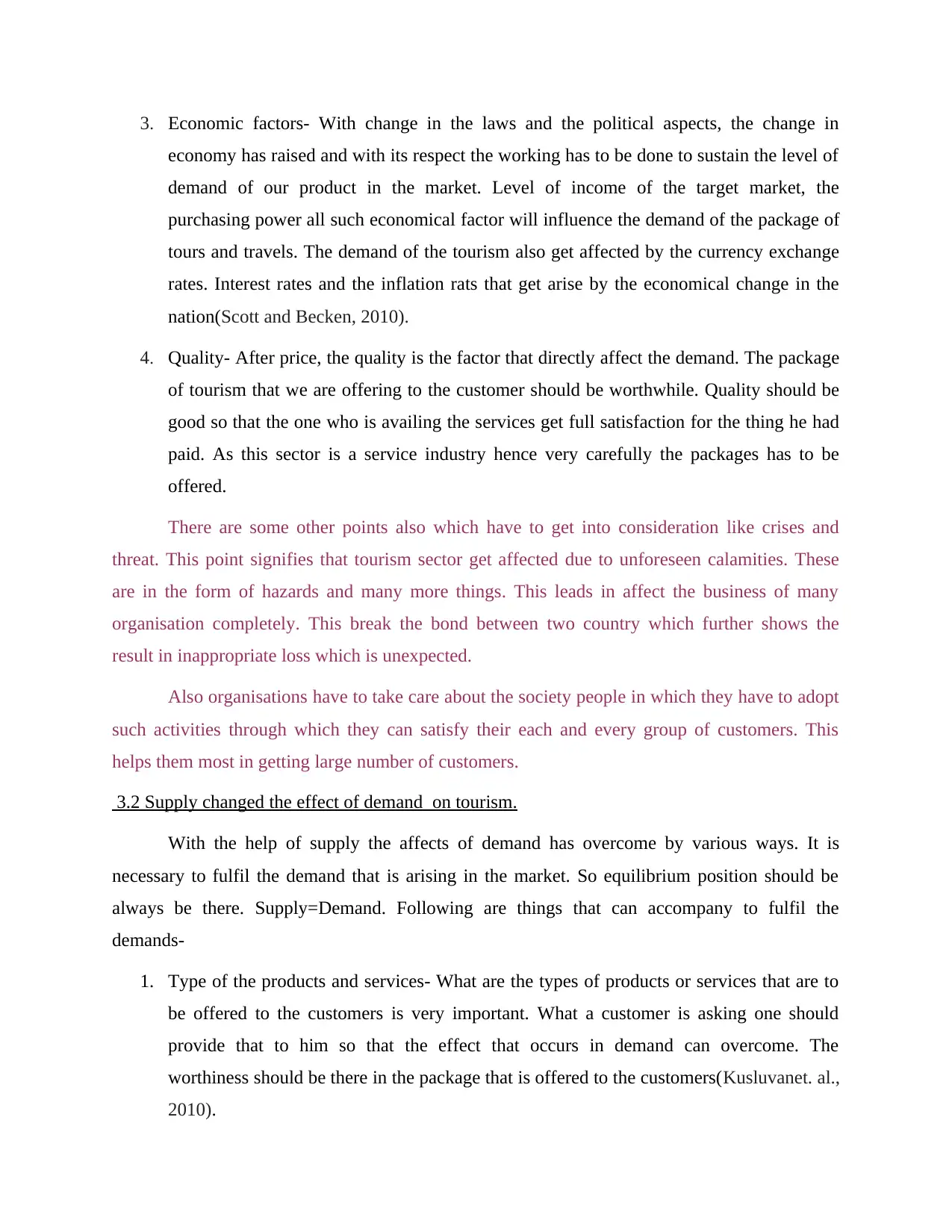
3. Economic factors- With change in the laws and the political aspects, the change in
economy has raised and with its respect the working has to be done to sustain the level of
demand of our product in the market. Level of income of the target market, the
purchasing power all such economical factor will influence the demand of the package of
tours and travels. The demand of the tourism also get affected by the currency exchange
rates. Interest rates and the inflation rats that get arise by the economical change in the
nation(Scott and Becken, 2010).
4. Quality- After price, the quality is the factor that directly affect the demand. The package
of tourism that we are offering to the customer should be worthwhile. Quality should be
good so that the one who is availing the services get full satisfaction for the thing he had
paid. As this sector is a service industry hence very carefully the packages has to be
offered.
There are some other points also which have to get into consideration like crises and
threat. This point signifies that tourism sector get affected due to unforeseen calamities. These
are in the form of hazards and many more things. This leads in affect the business of many
organisation completely. This break the bond between two country which further shows the
result in inappropriate loss which is unexpected.
Also organisations have to take care about the society people in which they have to adopt
such activities through which they can satisfy their each and every group of customers. This
helps them most in getting large number of customers.
3.2 Supply changed the effect of demand on tourism.
With the help of supply the affects of demand has overcome by various ways. It is
necessary to fulfil the demand that is arising in the market. So equilibrium position should be
always be there. Supply=Demand. Following are things that can accompany to fulfil the
demands-
1. Type of the products and services- What are the types of products or services that are to
be offered to the customers is very important. What a customer is asking one should
provide that to him so that the effect that occurs in demand can overcome. The
worthiness should be there in the package that is offered to the customers(Kusluvanet. al.,
2010).
economy has raised and with its respect the working has to be done to sustain the level of
demand of our product in the market. Level of income of the target market, the
purchasing power all such economical factor will influence the demand of the package of
tours and travels. The demand of the tourism also get affected by the currency exchange
rates. Interest rates and the inflation rats that get arise by the economical change in the
nation(Scott and Becken, 2010).
4. Quality- After price, the quality is the factor that directly affect the demand. The package
of tourism that we are offering to the customer should be worthwhile. Quality should be
good so that the one who is availing the services get full satisfaction for the thing he had
paid. As this sector is a service industry hence very carefully the packages has to be
offered.
There are some other points also which have to get into consideration like crises and
threat. This point signifies that tourism sector get affected due to unforeseen calamities. These
are in the form of hazards and many more things. This leads in affect the business of many
organisation completely. This break the bond between two country which further shows the
result in inappropriate loss which is unexpected.
Also organisations have to take care about the society people in which they have to adopt
such activities through which they can satisfy their each and every group of customers. This
helps them most in getting large number of customers.
3.2 Supply changed the effect of demand on tourism.
With the help of supply the affects of demand has overcome by various ways. It is
necessary to fulfil the demand that is arising in the market. So equilibrium position should be
always be there. Supply=Demand. Following are things that can accompany to fulfil the
demands-
1. Type of the products and services- What are the types of products or services that are to
be offered to the customers is very important. What a customer is asking one should
provide that to him so that the effect that occurs in demand can overcome. The
worthiness should be there in the package that is offered to the customers(Kusluvanet. al.,
2010).
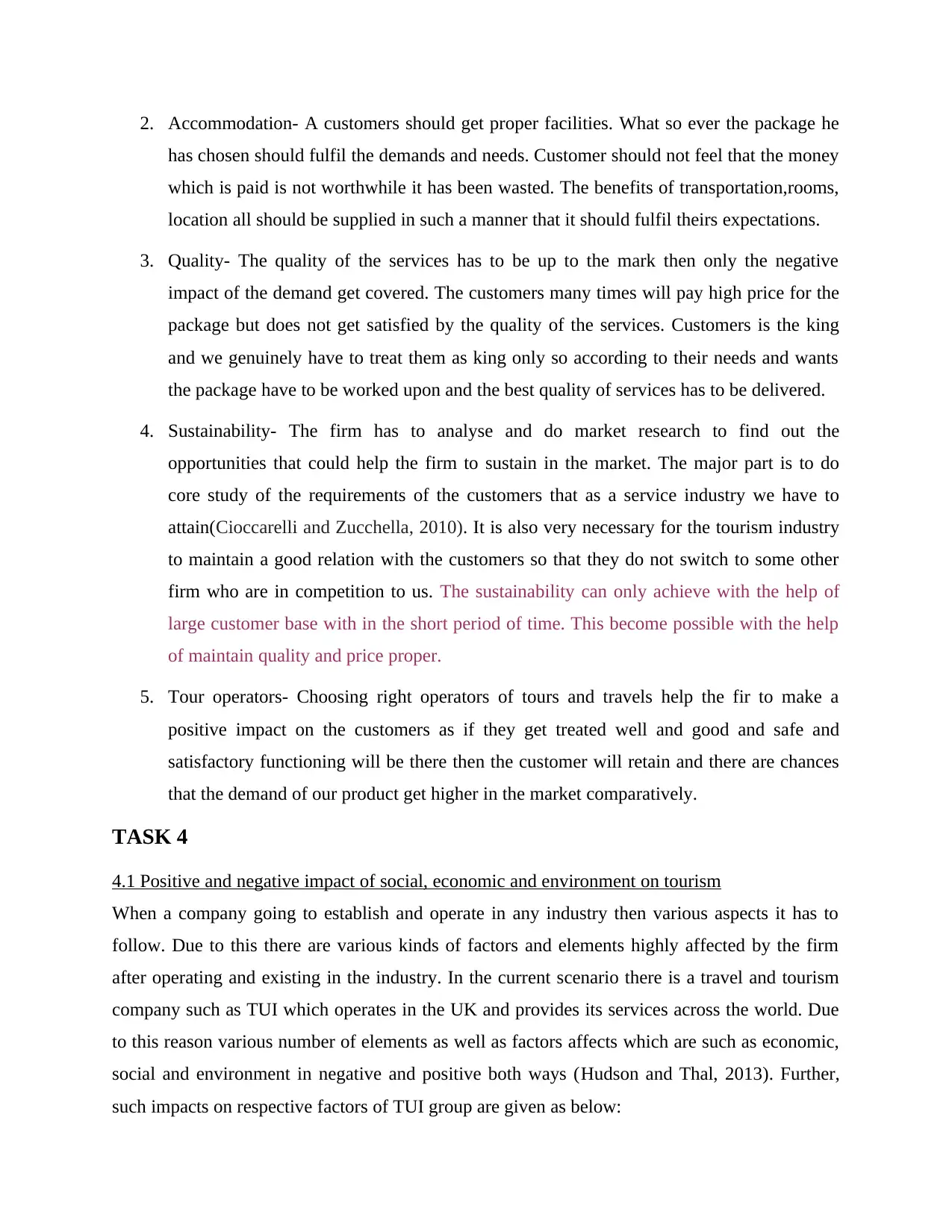
2. Accommodation- A customers should get proper facilities. What so ever the package he
has chosen should fulfil the demands and needs. Customer should not feel that the money
which is paid is not worthwhile it has been wasted. The benefits of transportation,rooms,
location all should be supplied in such a manner that it should fulfil theirs expectations.
3. Quality- The quality of the services has to be up to the mark then only the negative
impact of the demand get covered. The customers many times will pay high price for the
package but does not get satisfied by the quality of the services. Customers is the king
and we genuinely have to treat them as king only so according to their needs and wants
the package have to be worked upon and the best quality of services has to be delivered.
4. Sustainability- The firm has to analyse and do market research to find out the
opportunities that could help the firm to sustain in the market. The major part is to do
core study of the requirements of the customers that as a service industry we have to
attain(Cioccarelli and Zucchella, 2010). It is also very necessary for the tourism industry
to maintain a good relation with the customers so that they do not switch to some other
firm who are in competition to us. The sustainability can only achieve with the help of
large customer base with in the short period of time. This become possible with the help
of maintain quality and price proper.
5. Tour operators- Choosing right operators of tours and travels help the fir to make a
positive impact on the customers as if they get treated well and good and safe and
satisfactory functioning will be there then the customer will retain and there are chances
that the demand of our product get higher in the market comparatively.
TASK 4
4.1 Positive and negative impact of social, economic and environment on tourism
When a company going to establish and operate in any industry then various aspects it has to
follow. Due to this there are various kinds of factors and elements highly affected by the firm
after operating and existing in the industry. In the current scenario there is a travel and tourism
company such as TUI which operates in the UK and provides its services across the world. Due
to this reason various number of elements as well as factors affects which are such as economic,
social and environment in negative and positive both ways (Hudson and Thal, 2013). Further,
such impacts on respective factors of TUI group are given as below:
has chosen should fulfil the demands and needs. Customer should not feel that the money
which is paid is not worthwhile it has been wasted. The benefits of transportation,rooms,
location all should be supplied in such a manner that it should fulfil theirs expectations.
3. Quality- The quality of the services has to be up to the mark then only the negative
impact of the demand get covered. The customers many times will pay high price for the
package but does not get satisfied by the quality of the services. Customers is the king
and we genuinely have to treat them as king only so according to their needs and wants
the package have to be worked upon and the best quality of services has to be delivered.
4. Sustainability- The firm has to analyse and do market research to find out the
opportunities that could help the firm to sustain in the market. The major part is to do
core study of the requirements of the customers that as a service industry we have to
attain(Cioccarelli and Zucchella, 2010). It is also very necessary for the tourism industry
to maintain a good relation with the customers so that they do not switch to some other
firm who are in competition to us. The sustainability can only achieve with the help of
large customer base with in the short period of time. This become possible with the help
of maintain quality and price proper.
5. Tour operators- Choosing right operators of tours and travels help the fir to make a
positive impact on the customers as if they get treated well and good and safe and
satisfactory functioning will be there then the customer will retain and there are chances
that the demand of our product get higher in the market comparatively.
TASK 4
4.1 Positive and negative impact of social, economic and environment on tourism
When a company going to establish and operate in any industry then various aspects it has to
follow. Due to this there are various kinds of factors and elements highly affected by the firm
after operating and existing in the industry. In the current scenario there is a travel and tourism
company such as TUI which operates in the UK and provides its services across the world. Due
to this reason various number of elements as well as factors affects which are such as economic,
social and environment in negative and positive both ways (Hudson and Thal, 2013). Further,
such impacts on respective factors of TUI group are given as below:
⊘ This is a preview!⊘
Do you want full access?
Subscribe today to unlock all pages.

Trusted by 1+ million students worldwide
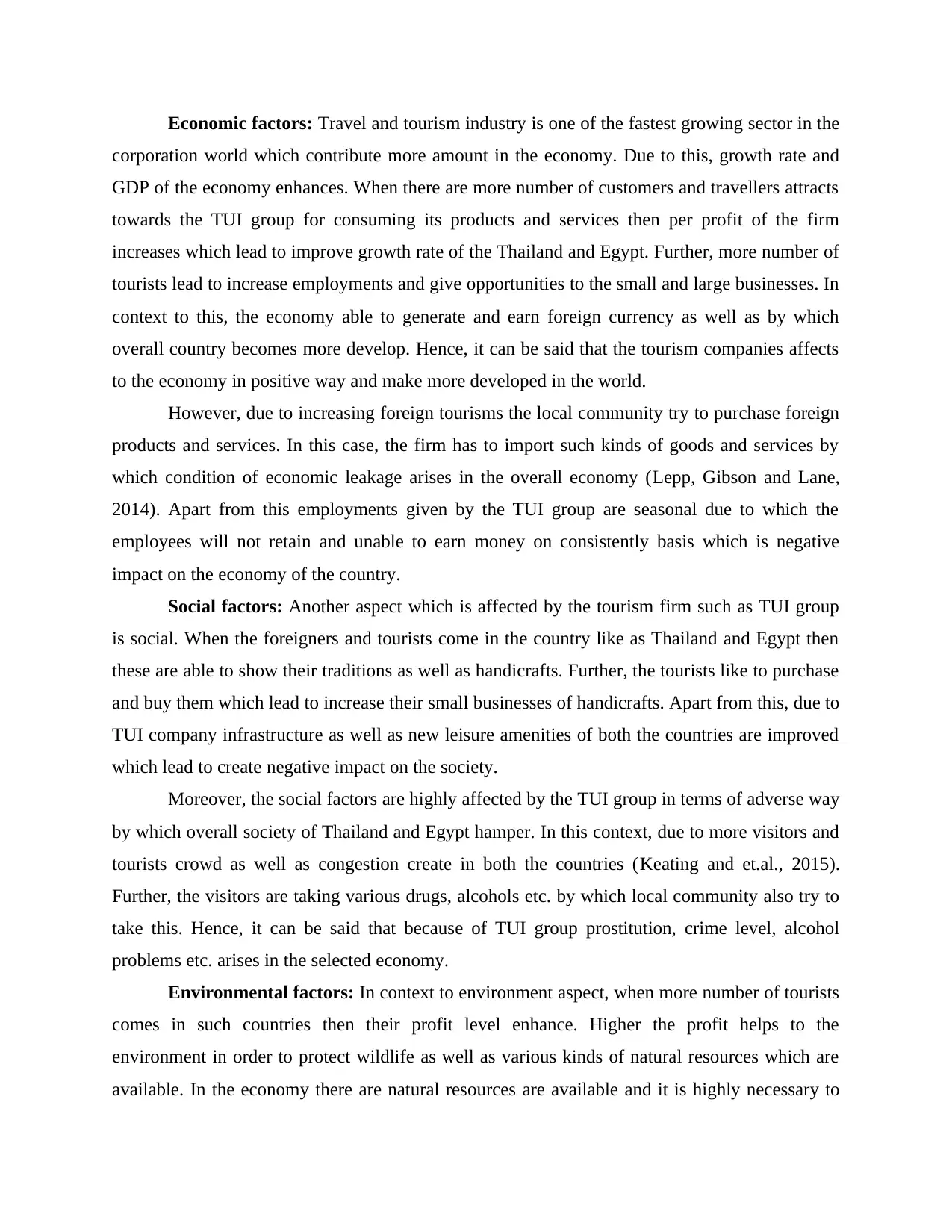
Economic factors: Travel and tourism industry is one of the fastest growing sector in the
corporation world which contribute more amount in the economy. Due to this, growth rate and
GDP of the economy enhances. When there are more number of customers and travellers attracts
towards the TUI group for consuming its products and services then per profit of the firm
increases which lead to improve growth rate of the Thailand and Egypt. Further, more number of
tourists lead to increase employments and give opportunities to the small and large businesses. In
context to this, the economy able to generate and earn foreign currency as well as by which
overall country becomes more develop. Hence, it can be said that the tourism companies affects
to the economy in positive way and make more developed in the world.
However, due to increasing foreign tourisms the local community try to purchase foreign
products and services. In this case, the firm has to import such kinds of goods and services by
which condition of economic leakage arises in the overall economy (Lepp, Gibson and Lane,
2014). Apart from this employments given by the TUI group are seasonal due to which the
employees will not retain and unable to earn money on consistently basis which is negative
impact on the economy of the country.
Social factors: Another aspect which is affected by the tourism firm such as TUI group
is social. When the foreigners and tourists come in the country like as Thailand and Egypt then
these are able to show their traditions as well as handicrafts. Further, the tourists like to purchase
and buy them which lead to increase their small businesses of handicrafts. Apart from this, due to
TUI company infrastructure as well as new leisure amenities of both the countries are improved
which lead to create negative impact on the society.
Moreover, the social factors are highly affected by the TUI group in terms of adverse way
by which overall society of Thailand and Egypt hamper. In this context, due to more visitors and
tourists crowd as well as congestion create in both the countries (Keating and et.al., 2015).
Further, the visitors are taking various drugs, alcohols etc. by which local community also try to
take this. Hence, it can be said that because of TUI group prostitution, crime level, alcohol
problems etc. arises in the selected economy.
Environmental factors: In context to environment aspect, when more number of tourists
comes in such countries then their profit level enhance. Higher the profit helps to the
environment in order to protect wildlife as well as various kinds of natural resources which are
available. In the economy there are natural resources are available and it is highly necessary to
corporation world which contribute more amount in the economy. Due to this, growth rate and
GDP of the economy enhances. When there are more number of customers and travellers attracts
towards the TUI group for consuming its products and services then per profit of the firm
increases which lead to improve growth rate of the Thailand and Egypt. Further, more number of
tourists lead to increase employments and give opportunities to the small and large businesses. In
context to this, the economy able to generate and earn foreign currency as well as by which
overall country becomes more develop. Hence, it can be said that the tourism companies affects
to the economy in positive way and make more developed in the world.
However, due to increasing foreign tourisms the local community try to purchase foreign
products and services. In this case, the firm has to import such kinds of goods and services by
which condition of economic leakage arises in the overall economy (Lepp, Gibson and Lane,
2014). Apart from this employments given by the TUI group are seasonal due to which the
employees will not retain and unable to earn money on consistently basis which is negative
impact on the economy of the country.
Social factors: Another aspect which is affected by the tourism firm such as TUI group
is social. When the foreigners and tourists come in the country like as Thailand and Egypt then
these are able to show their traditions as well as handicrafts. Further, the tourists like to purchase
and buy them which lead to increase their small businesses of handicrafts. Apart from this, due to
TUI company infrastructure as well as new leisure amenities of both the countries are improved
which lead to create negative impact on the society.
Moreover, the social factors are highly affected by the TUI group in terms of adverse way
by which overall society of Thailand and Egypt hamper. In this context, due to more visitors and
tourists crowd as well as congestion create in both the countries (Keating and et.al., 2015).
Further, the visitors are taking various drugs, alcohols etc. by which local community also try to
take this. Hence, it can be said that because of TUI group prostitution, crime level, alcohol
problems etc. arises in the selected economy.
Environmental factors: In context to environment aspect, when more number of tourists
comes in such countries then their profit level enhance. Higher the profit helps to the
environment in order to protect wildlife as well as various kinds of natural resources which are
available. In the economy there are natural resources are available and it is highly necessary to
Paraphrase This Document
Need a fresh take? Get an instant paraphrase of this document with our AI Paraphraser
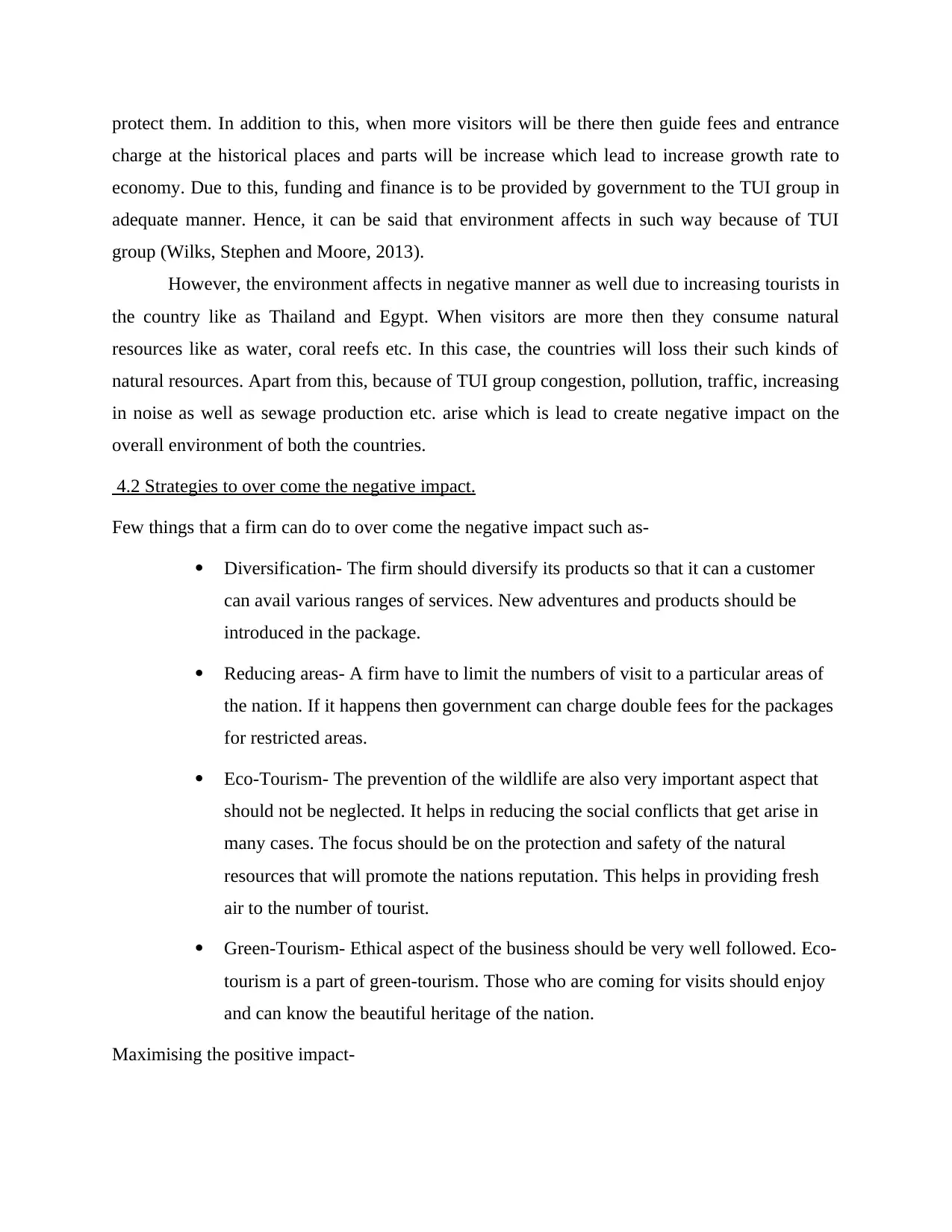
protect them. In addition to this, when more visitors will be there then guide fees and entrance
charge at the historical places and parts will be increase which lead to increase growth rate to
economy. Due to this, funding and finance is to be provided by government to the TUI group in
adequate manner. Hence, it can be said that environment affects in such way because of TUI
group (Wilks, Stephen and Moore, 2013).
However, the environment affects in negative manner as well due to increasing tourists in
the country like as Thailand and Egypt. When visitors are more then they consume natural
resources like as water, coral reefs etc. In this case, the countries will loss their such kinds of
natural resources. Apart from this, because of TUI group congestion, pollution, traffic, increasing
in noise as well as sewage production etc. arise which is lead to create negative impact on the
overall environment of both the countries.
4.2 Strategies to over come the negative impact.
Few things that a firm can do to over come the negative impact such as-
Diversification- The firm should diversify its products so that it can a customer
can avail various ranges of services. New adventures and products should be
introduced in the package.
Reducing areas- A firm have to limit the numbers of visit to a particular areas of
the nation. If it happens then government can charge double fees for the packages
for restricted areas.
Eco-Tourism- The prevention of the wildlife are also very important aspect that
should not be neglected. It helps in reducing the social conflicts that get arise in
many cases. The focus should be on the protection and safety of the natural
resources that will promote the nations reputation. This helps in providing fresh
air to the number of tourist.
Green-Tourism- Ethical aspect of the business should be very well followed. Eco-
tourism is a part of green-tourism. Those who are coming for visits should enjoy
and can know the beautiful heritage of the nation.
Maximising the positive impact-
charge at the historical places and parts will be increase which lead to increase growth rate to
economy. Due to this, funding and finance is to be provided by government to the TUI group in
adequate manner. Hence, it can be said that environment affects in such way because of TUI
group (Wilks, Stephen and Moore, 2013).
However, the environment affects in negative manner as well due to increasing tourists in
the country like as Thailand and Egypt. When visitors are more then they consume natural
resources like as water, coral reefs etc. In this case, the countries will loss their such kinds of
natural resources. Apart from this, because of TUI group congestion, pollution, traffic, increasing
in noise as well as sewage production etc. arise which is lead to create negative impact on the
overall environment of both the countries.
4.2 Strategies to over come the negative impact.
Few things that a firm can do to over come the negative impact such as-
Diversification- The firm should diversify its products so that it can a customer
can avail various ranges of services. New adventures and products should be
introduced in the package.
Reducing areas- A firm have to limit the numbers of visit to a particular areas of
the nation. If it happens then government can charge double fees for the packages
for restricted areas.
Eco-Tourism- The prevention of the wildlife are also very important aspect that
should not be neglected. It helps in reducing the social conflicts that get arise in
many cases. The focus should be on the protection and safety of the natural
resources that will promote the nations reputation. This helps in providing fresh
air to the number of tourist.
Green-Tourism- Ethical aspect of the business should be very well followed. Eco-
tourism is a part of green-tourism. Those who are coming for visits should enjoy
and can know the beautiful heritage of the nation.
Maximising the positive impact-
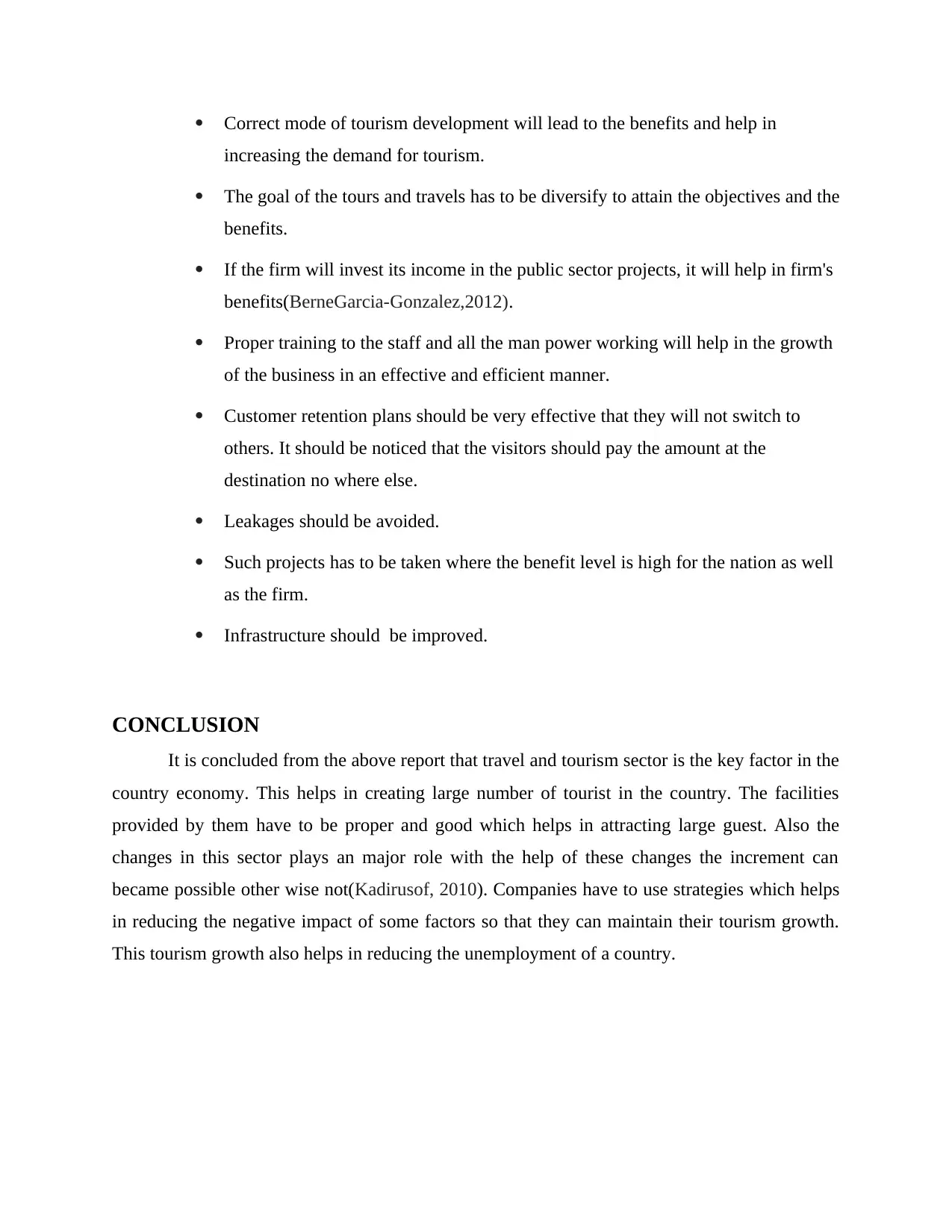
Correct mode of tourism development will lead to the benefits and help in
increasing the demand for tourism.
The goal of the tours and travels has to be diversify to attain the objectives and the
benefits.
If the firm will invest its income in the public sector projects, it will help in firm's
benefits(BerneGarcia-Gonzalez,2012).
Proper training to the staff and all the man power working will help in the growth
of the business in an effective and efficient manner.
Customer retention plans should be very effective that they will not switch to
others. It should be noticed that the visitors should pay the amount at the
destination no where else.
Leakages should be avoided.
Such projects has to be taken where the benefit level is high for the nation as well
as the firm.
Infrastructure should be improved.
CONCLUSION
It is concluded from the above report that travel and tourism sector is the key factor in the
country economy. This helps in creating large number of tourist in the country. The facilities
provided by them have to be proper and good which helps in attracting large guest. Also the
changes in this sector plays an major role with the help of these changes the increment can
became possible other wise not(Kadirusof, 2010). Companies have to use strategies which helps
in reducing the negative impact of some factors so that they can maintain their tourism growth.
This tourism growth also helps in reducing the unemployment of a country.
increasing the demand for tourism.
The goal of the tours and travels has to be diversify to attain the objectives and the
benefits.
If the firm will invest its income in the public sector projects, it will help in firm's
benefits(BerneGarcia-Gonzalez,2012).
Proper training to the staff and all the man power working will help in the growth
of the business in an effective and efficient manner.
Customer retention plans should be very effective that they will not switch to
others. It should be noticed that the visitors should pay the amount at the
destination no where else.
Leakages should be avoided.
Such projects has to be taken where the benefit level is high for the nation as well
as the firm.
Infrastructure should be improved.
CONCLUSION
It is concluded from the above report that travel and tourism sector is the key factor in the
country economy. This helps in creating large number of tourist in the country. The facilities
provided by them have to be proper and good which helps in attracting large guest. Also the
changes in this sector plays an major role with the help of these changes the increment can
became possible other wise not(Kadirusof, 2010). Companies have to use strategies which helps
in reducing the negative impact of some factors so that they can maintain their tourism growth.
This tourism growth also helps in reducing the unemployment of a country.
⊘ This is a preview!⊘
Do you want full access?
Subscribe today to unlock all pages.

Trusted by 1+ million students worldwide
1 out of 15
Related Documents
Your All-in-One AI-Powered Toolkit for Academic Success.
+13062052269
info@desklib.com
Available 24*7 on WhatsApp / Email
![[object Object]](/_next/static/media/star-bottom.7253800d.svg)
Unlock your academic potential
Copyright © 2020–2025 A2Z Services. All Rights Reserved. Developed and managed by ZUCOL.





